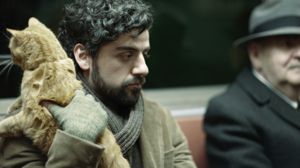I can't imagine what it feels like to have herding cats in your job description. Being asked to train the trio of felines playing the cat that Llewyn Davis keeps losing and finding would have been tricky enough without all the subway rides, street chases and window escapes during folk music sessions required. But then there's the added expectation for the cat to provide - as directors Joel and Ethan Coen freely admit - much of the plot for the movie.
No pressure, right Dawn?
Inside Llewyn Davis follows a talented folksinger (Oscar Isaac) as he trudges through his daily struggle to survive in 1961 New York. He's constantly alienating people and ruining his personal and professional relationships, until it seems like only your cat is left to redeem him. The pet of friends that he inadvertently lets escape its apartment, Davis' concern over returning the cat is often the audience's only clue that Davis may have once been a good person. There are many scenes of people telling Davis how awful he is: Carey Mulligan's perpetually angry Jean in particular, though she has good reason - she's pregnant after a regrettable fling with Davis. We see him throwing away opportunities and being cruel to those who don't meet his exacting and sometimes contradictory standards for authentic music. In other words, he's a jerk. But then there's the cat, and we see Davis cuddling it or desperately searching for it, even taking it along on his last ditch road trip to see a music manager in Chicago. In those moments it's possible to see Davis not as a perpetual loser deserving of his fate, but as a damaged person, still reeling from the death of his singing partner, and exhausted from the grind of singing his heart out and failing to connect.
The structure of Inside Llewyn Davis is circular but feels more like a spiral as Davis' options narrow. There's the sense that he's trapped in this cycle, that the change we know is coming - Bob Dylan is waiting in the wings to electrify the folk scene - will pass Davis by. There's not a lot of hope, but then there's that cat again, whose name reveal near the end of the movie gives us just a sense that sometimes a journey back to where you began is not a bad thing.
The cat represents many things - it drives the narrative, it could be symbol of Davis' lost partner, or the elusive nature of art itself. Losing and finding the cat is therefore something we and Llewyn Davis feel strongly about. Well that, and because it's also a pretty cute cat.
There was a lot riding on your shoulders, Dawn (and those of your cats), but you managed to pull it off brilliantly.







